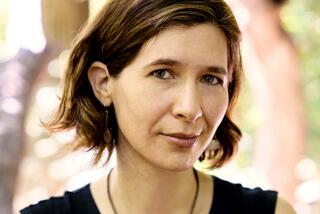‘Fairy Tales From the Brothers Grimm’ casts a spell
- Share via
Fairy Tales From the Brothers Grimm
A New English Version
Philip Pullman
Viking: 400 pp, $27.95
Freudian, Marxist, feminist — fairy tales have famously been put through any number of academic paces, mined for their politics, their unconscious symbolism, their cultural freight and transformative powers. These tales, nearly allegorically flat, cut to the chase of human nightmares: hungry wolves and evil stepmothers. Here are life’s fundamental anxieties by proxy, what Harvard professor Maria Tatar called “the great existential mysteries, in a miniature and manageable form.”
Is it any wonder that their popularity refuses to fade? Who among us has not spent a season lost in the metaphorical woods, in need of a few magical tips for outsmarting life’s ceaseless parade of ogres? “We are all misfit for the world,” fairy tale scholar Jack Zipes has noted, “and we must all fit in....”
It is the craft of storytelling, however, and not the deeper mystery of these stories, that Philip Pullman stakes out as his territory in his charming new translation of “Fairy Tales From the Brothers Grimm,” retold here with an ear for rhythm and dramatic timing, for speeding toward terrible fates and poetic justice, and a fidelity that isn’t engineered to lead readers down any one particular path.
“Much ingenious interpretation of story is little more than seeing pleasing patterns in the sparks of a fire,” Pullman writes, “but it does no harm.”
It’s hard indeed to imagine Pullman arguing for the deleterious effects of erudition — this is the man who based his “His Dark Materials” trilogy of YA books on Milton’s “Paradise Lost” — and here, in fact, he’s appended scholarly annotations to each of the stories, including the folklorist’s tale type, sources and groupings of related stories from around the world. His notes often also point toward the work of theorists such as Zipes, Tatar and Marina Warner, while Pullman himself now and again drops in linguistic, historical and cultural asides in his readable style.
But while authors as varied as Margaret Atwood, Angela Carter and Charlotte Bronte have engaged in radical reworkings of folk tale motifs over the years, Pullman’s take hews rather closely to the spirit of the originals. And though his language might now and again veer toward the modern, and many plots show the studied effects of the author’s hand, they retain their bucolic yet treacherous world and its often rough magic, where a frog prince is altogether much more likely to be thrown hard up against the wall than gently kissed, and not every villager is assured his happily ever after.
In doing so, Pullman’s retellings can render the tales less cartoonish, and consequently more affecting, than those much of the modern audience has likely become accustomed to. Folk tales didn’t originate sweetly as children’s stories but as often violent and bawdy entertainment for pre-modern adults to pass the time. Taken aback by their inadvertently popular success, the Brothers Grimm might have consciously reworked the tales in their successive volumes, tweaking their more unsavory elements and adding in moral edification for the young ones, but still, their collection retained enough bloody-mindedness that Allied forces banned the book in Germany after the war.
In late 20th century California, it took only a bottle of wine to get Little Red Riding Hood booted from a public school library (the book showed the title character taking wine and food to grandma). Whether modern parents object to retro gender roles or mature themes, the debate over whether classic fairy tales are fit for impressionable young minds hasn’t exactly been put to rest, despite Disney’s best efforts.
After all, the original Cinderella, or Aschenputtell, as the Grimms knew her, didn’t have a magical pumpkin or a fairy godmother for backup, just a benevolent hazel tree growing out from her dear mother’s grave, a more haunting evocation of what it means to be alone in the world. Likewise, her story explores a crueler resolution to its sibling rivalry. In the end, Aschenputtell gets her prince, while her haughty stepsisters get their eyes pecked out by doves.
As the narrator of “The Cat and the Mouse Set Up House,” one of the breezy cautionary tales Pullman animates here, might well ask, “Well, what else did you expect? That’s just the sort of thing that happens in this world.”
More to Read
Sign up for our Book Club newsletter
Get the latest news, events and more from the Los Angeles Times Book Club, and help us get L.A. reading and talking.
You may occasionally receive promotional content from the Los Angeles Times.





